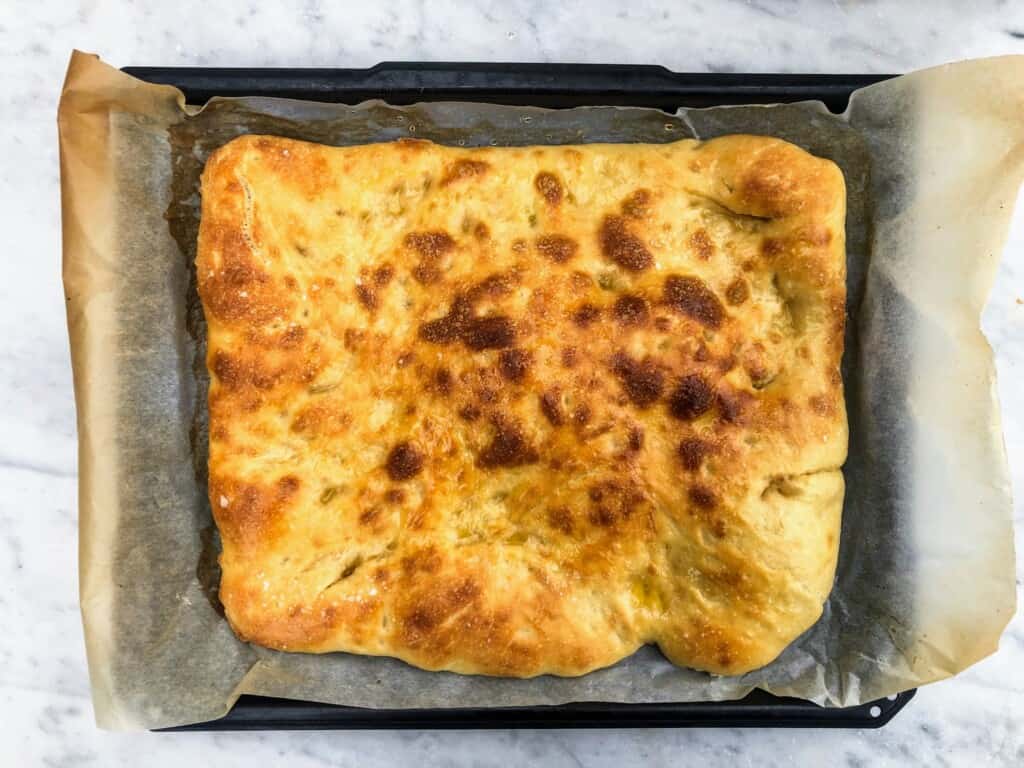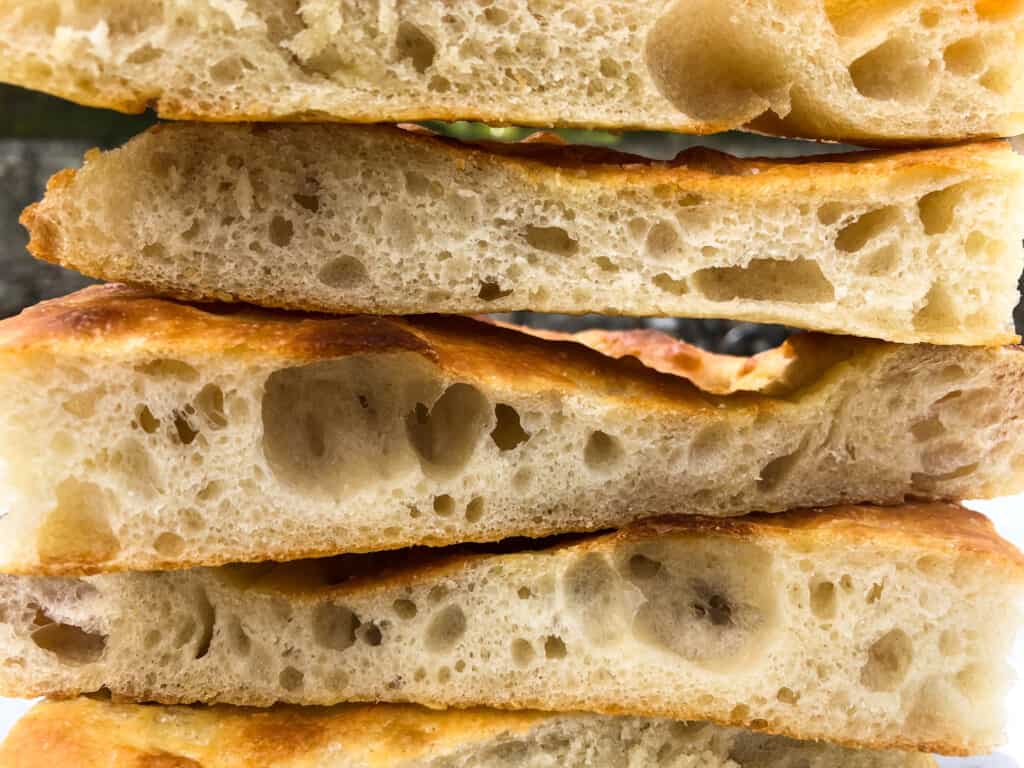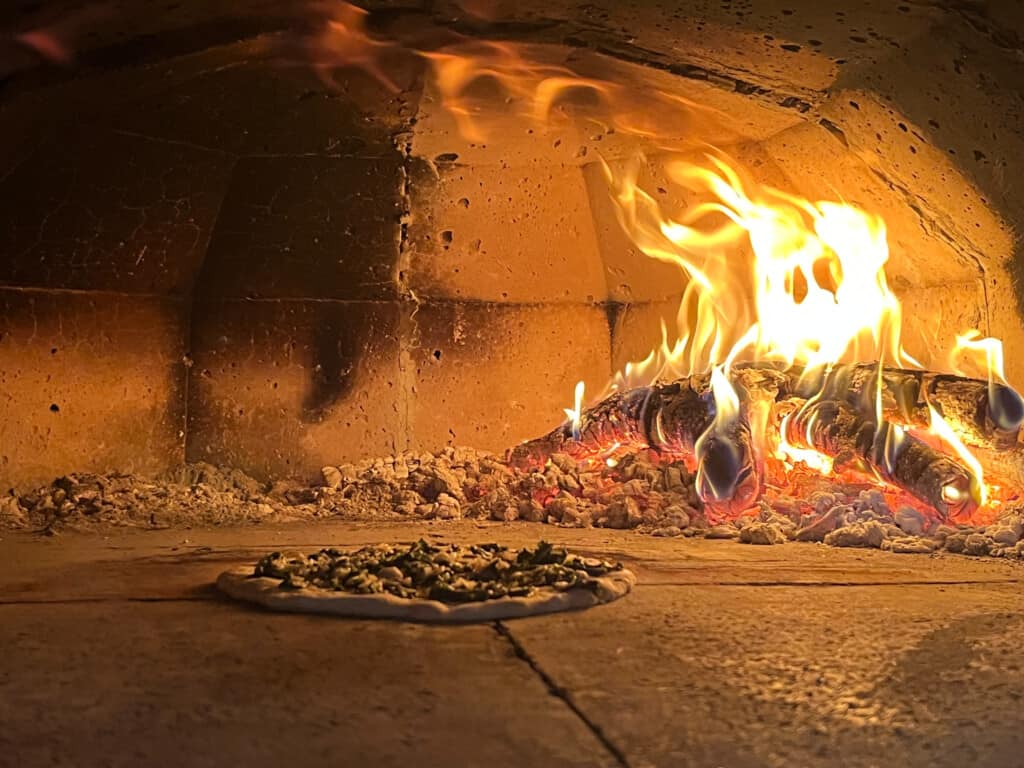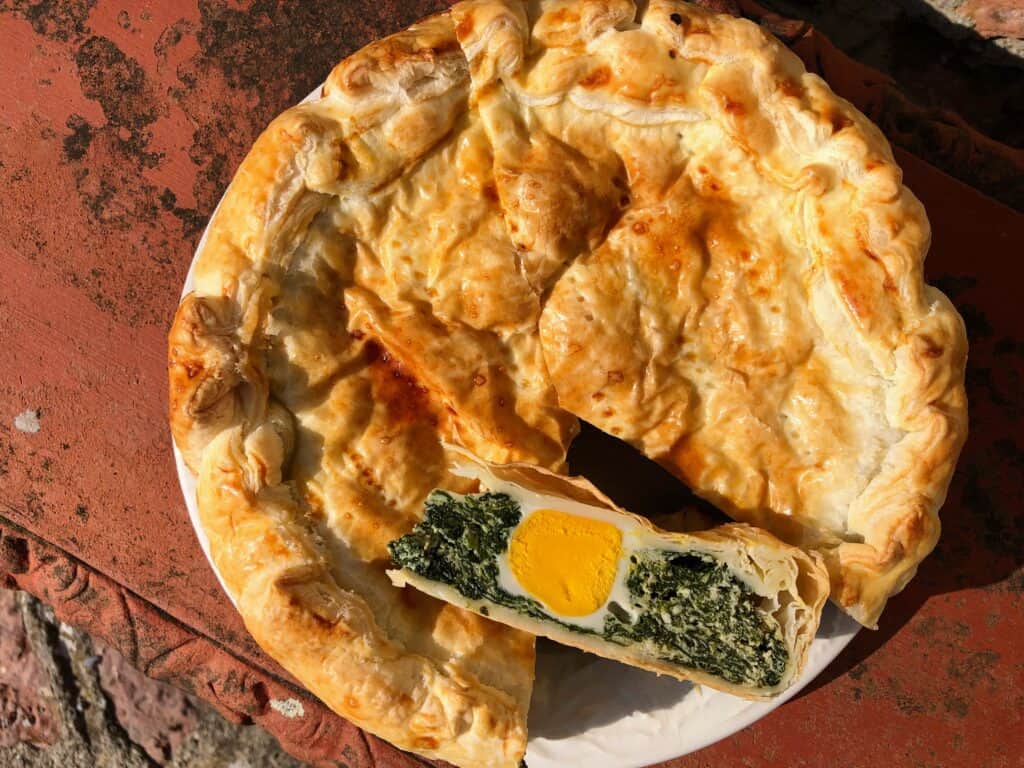Last updated on March 17th, 2024
Are you still dreaming of the schiacciata bread you had on your recent travels to Tuscany? Or maybe it’s been years since your trip but you can still remember to this day how amazing the local schiacciata was? Are you now ready to try it at home?
I have to admit that making flatbread is a bit of an artform but anyone with a bit of patience can do it! Once you learn the key differences between this schiacciata recipe and traditional ligurian focaccia, you will soon be whipping up this easy, no-fuss, authentic schiacciata bread on a weekly basis.
This schiacciata recipe is my family’s version of authentic Tuscan schiacciata. Schiacciata is similar to focaccia but it’s typically more chewy while Ligurian focaccia tends to be more airy and spongy.
This is a favorite throughout Tuscany and for my family. I guarantee it will be a favorite of yours too once you start making schiacciata toscana and playing with all the different ways you can eat it!
Jump to Section
Schiacciata Pronunciation
Schiacciata in the Tuscan word for focaccia, pronounced skee-ahch-chyah-tah. The name schiacciata comes from the word schiacciare, meaning to squash, referring to the process of squashing the dough out into the pan with your hands.
Listen to the pronunciation of schiacciata here:
What Is Schiacciata?

Schiacciata, also known as schiacciata toscana, is just one type of Italian flatbread typically made in Tuscany but you will also find it in Umbria.
Schiacciata toscana is Tuscany’s version of focaccia, characterized by its pillowy center filled with large air pockets and crunchy, crispy, golden crust.
Schiacciata is a typical snack or sandwich bread sold by weight in bakeries, grocery stores and specialty food shops. You can either buy it all’olio, made simply with salt and oil or it might be dressed up with things like olives, onions, tomatoes, zucchini or other seasonal produce. It’s one of my favorite grocery store snacks and one of my favorite snacks to eat in Italy while pregnant.
Fact: Schiacciata in other regions is sometimes known as pizza bianca, which just refers to the local recipe for olive oil focaccia.
More Veg Please: Check out my list of Vegetarian Dishes to Try in Italy.
The Difference Between Schiacciata and Focaccia

Upon a first glance, schiacciata and focaccia may seem similar but there are some key differences. Typically, schiacciata is made with more flour than focaccia and has a shorter rising time. Focaccia usually has more oil but not always and is typical of Liguria. Schiacciata is found in Tuscany.
The largest difference, however, is the brine that is poured onto the Ligurian focaccia before baking, giving it a very salty, briny bite. Schiacciata tends to be a bit thinner, more crunchy and chewy while Ligurian focaccia has a softer, more spongy inside and tends to be a bit thicker.
Both schiacciata and focaccia can be used interchangeably. They are both enjoyed as snacks and used to make sandwiches out of. The most common kind of both is all’olio or just with oil but both will be made with various toppings.
Tip: You can use either schiacciata or focaccia to make your own focaccia art. Get our recipe for authentic focaccia here.
The Difference Between Schiacciata and Schiacciata Fiorentina

Schiacciata alla fiorentina is a yeasted bread, just like schiacciata toscana but it’s sweet and is finished with powdered sugar or filled with cream.
Schiacciata alla fiorentina is a pillowy cake flavored with orange zest made only for Carnival in Florence. You can find it throughout Tuscany from January through March but it’s the best in the city center where it originated.
Ingredients For Schiacciata Recipe

- 1.5 cups + 2 tablespoons (200 grams) baking flour
- 3.5 cups (300 grams) bread flour
- 1 teaspoon active dry yeast
- 350 ml water
- 1 teaspoon salt
- 1 ½ tablespoons olive oil + more for baking
Good To Know: If you have ever made Ligurian focaccia, then you will notice the ingredients and instructions are similar.
Water
Lukewarm tap water is fine. It should not feel hot but it should neither be cold, which is important for activating the yeast.
Flour
For schiacciata toscana, I find it best to use a mix of baking flour and all-purpose flour. The baking flour has a higher protein content, making a more stable and elastic dough while all-purpose keeps the dough soft and light.
To learn more about flour, read Guide to Italian Flour – Straight from Italy.
Salt

Here in Italy we use regular table salt for most things but you can certainly use Kosher salt if you prefer. If you use Kosher salt, be sure to double the indicated amounts as its less salty than sea salt.
For a finishing salt, a flakey sea salt is best such as Maldon.
Extra Virgin Olive Oil

Use whatever extra virgin olive oil is affordable and convenient for you. Because extra virgin olive oil is easy to come by in Tuscany, that is what most schiacciata recipes call for. The better the oil, the better the schiacciata.
Nice to Know: You can absolutely substitute with regular olive oil if you don’t have extra virgin olive oil.
For our suggestions and guide to buying olive oils read 15 Best Italian Olive Oils – To Enjoy in Italy & Bring Home as a Souvenir and Best Italian Olive Oil Brands in America – Where to Buy Them and How to Store Them.
How To Make Schiacciata Toscana
In a large bowl or with a stand mixer fitted with the dough hook, dissolve the yeast in the water. Mix well and add the two flours.
Add the salt and olive oil and continue to mix until well incorporated. If using a stand mixer, mix for two or three minutes until the dough is smooth. If mixing by hand, continue to mix with a wooden spoon and then with your hands by lifting up a corner of the dough and folding it back over the dough.

Rotate the bowl and continue in this manner. (it can get very messy with your hands but don’t be afraid – your hands are your best tools).
Let rise for two hours until doubled in size, performing a series of four folds every 30 minutes by lifting up one corner of the dough with a wet hand, pulling it up and bringing it back down on top of the dough on the opposite side. Turn the bowl a quarter of a turn and repeat 3 more times until all the dough has been folded upon itself. Keep the bowl covered with plastic wrap between folds and for the rest of the rise.
Put in the refrigerator for a minimum of 12 hours.
Remove from the refrigerator four hours before baking. Let the schiacciata dough come to room temperature for two hours. After these two hours, perform a series of additional four ‘folds’ or ‘lifts’ by lifting the dough up from the sides and dropping it back down every 30 minutes two more hours.
Line a 17×11.5 inches (more or less) rimmed baking sheet with parchment paper.

Drizzle the parchment paper with olive oil and turn the dough out onto the baking sheet. If you want to use less oil, you can dust the parchment paper with flour and use lightly floured hands to stretch the dough out. Both methods are used in traditional schiacciata. Using slightly wet or oiled hands, pull and stretch the dough out into an even square/rectangle (or whatever shape you can manage; it can be a little challenging to spread out), pulling from the underside of the dough outward. Dimple it with your fingers (keep your fingers moist to keep them from sticking).
Let rise for at least one hour while the oven is preheating to 475° F (245° C). Check on the dough and if it has shrunk back, gently pull it out again within this one hour time frame, being careful not to deflate the dough too much.

Sprinkle with just a tad bit of water, drizzle with olive oil and salt well with a flaky salk like Maldon.
Bake for 13-17 minutes in the middle of the oven until golden brown and crunchy.

Transfer the schiacciata to a wire wrack and let cool completely before serving.
Substitutions For Schiacciata

- Use a portion of whole wheat flour instead of white (you may need to adjust the water amount by adding slightly more as whole wheat flour absorbs more water. Always start with a little – less is more!).
- Sprinkle rosemary or other herbs on top before baking.
How Schiacciata Is Eaten

In Tuscany, schiacciata is eaten most commonly served cut into strips as a snack or used to make a panino. It may also be served along a meal but this is less common as pane toscano is preferred. Here are some of our favorite ways to eat it:
- Simply cut into strips about 1-1 ½ inch thick and eaten as a snack
- Cut open horizontally and filled with prosciutto crudo and pecorino cheese
- Slathered with Nutella (a favorite of my children although it’s reserved for special treats)
- with soups at lunch
- in small bites with an aperitivo
- with summer salads such as caprese or green salads
Fact: Shops with the word schiacciata in the title, meaning they specialize in sandwiches made with schiacciata.
Notes and Tips For Making Schiacciata

- This dough is much easier to manage and handle if you can mix it with a stand mixer.
- Making bread is a messy business and takes practice. Don’t fret if it doesn’t always come out as you hope. There are lots of factors that affect baking bread such as temperature, humidity, time of year, brand of flour, altitude and water.
- Let the dough rise for as long as 20 hours in the fridge before bringing back out to room temperature to fold, shape and bake.
- If you want to use less oil, you can spread the dough out on a floured surface and then transfer it to a parchment lined baking sheet.
- Use this schiacciata recipe for making potato pizza or adding other toppings.
Toppings For Schiacciata

Schiacciata is really just a basic flatbread that you can dress up with any flavor or texture you like. Be creative and have fun with what is seasonal and local, just as we do here in Italy. Add the toppings and then let your schiacciata rise the final hour before baking.
Popular schiacciata toppings:
- olives
- cherry tomatoes (cut in half)
- potato (thinly sliced)
- onions (thinly sliced or caramelized)
- mushrooms (pan sauté)
- prosciutto (add after the schiacciata is cooked)
- zucchini
- roasted red peppers
- tomato sauce (called pizza rossa in Italian).
Baking Schedule For Schiacciata

This is my personal baking schedule for schiacciata that allows me to bake stress-free on the weekends. This is just a guide but it can be helpful as a guideline to adapt to your own working and personal schedule.
Day Beforehand:
6:00 pm: make the dough
6:00-8:00 pm: fold the dough and refrigerate overnight
Baking Day:
6:00 am: pull dough out of fridge and let come to room temperature
8:00 am: perform bread ‘lifts’ to develop strength
10:00 am: preheat oven and spread out onto tray
11:00 am: bake schiacciata
Good To Know: Any of these times can be modified slightly. For example, I could make the dough at any time in the afternoon and just refrigerate until the next morning or you could pull the dough out later in the morning and bake in the early afternoon.

Schiacciata
Ingredients
- 1.5 cups baking flour + 2 Tbsp (200 g)
- 3.5 cups bread flour (300 g)
- 1 tsp active dry yeast
- 350 ml water
- 1 tsp salt
- 1.5 Tbsp olive oil + more for baking
Instructions
- In a large bowl, dissolve the yeast in the water. Mix well and add the two flours.
- Either by hand or with a stand mixer fitted with the dough hook, mix until well combined. Add the salt and olive oil and continue to mix until well incorporated. If using a stand mixer, mix for two or three minutes until the dough is smooth. If mixing by hand, continue to mix with a wooden spoon and then with your hands by lifting up a corner of the dough and folding it back over the dough.
- Rotate the bowl and continue in this manner. (it can get very messy with your hands but don’t be afraid – your hands are your best tools).
- Let rise for two hours until doubled in size, performing a series of four folds every 30 minutes by lifting up one corner of the dough with a wet hand, pulling it up and bringing it back down on top of the dough on the opposite side. Turn the bowl a quarter of a turn and repeat 3 more times until all the dough has been folded upon itself.
- Put in the refrigerator for a minimum of 12 hours.
- Line a 17×11.5 inches (more or less) rimmed baking sheet with parchment paper.
- Drizzle the parchment paper with olive oil and turn the dough out onto the baking sheet. If you want to use less oil, you can dust the parchment paper with flour and use lightly floured hands to stretch the dough out. Both methods are used in traditional schiacciata. Using slightly wet or oiled hands, pull and stretch the dough out into an even square/rectangle (or whatever shape you can manage; it can be a little challenging to spread out), pulling from the underside of the dough outward. Dimple it with your fingers (keep your fingers moist to keep them from sticking).
- Let rise for at least 1 hour while the oven is preheating to 475° F (245° C). Check on the dough and if it has shrunk back, gently pull it out again within this one hour time frame, being careful not to deflate the dough too much.
- Sprinkle with just a tad bit of water, drizzle with olive oil and salt well with a flaky salk like Maldon.
- Bake for 13-17 minutes in the middle of the oven until golden brown and crunchy.
- Transfer the schiacciata to a wire wrack and let cool completely before serving.
Notes
- This dough is much easier to manage and handle if you can mix it with a stand mixer.
- Making bread is a messy business and takes practice. Don’t fret if it doesn’t always come out as you hope. There are lots of factors that affect baking bread such as temperature, humidity, time of year, brand of flour, altitude and water.
- Let the dough rise for as long as 20 hours in the fridge before bringing back out to room temperature to fold, shape and bake.
- If you want to use less oil, you can spread the dough out on a floured surface and then transfer it to a parchment lined baking sheet.
- Use this schiacciata recipe for making potato pizza or adding other toppings.
Try It: You may also like making our Pinsa Recipe.
Schiacciata Recipe FAQ
Yes, you can but it’s the best the same day it’s prepared. If you are going to save it, keep it in an airtight bag and reheat lightly in an oven for the best results.
Store schiacciata in a sealed bag for one day.
In Tuscany, Italians most typically eat schiacciata as a snack in strips, in small bites as an aperitivo or to make sandwiches with. It’s not usually served at the table with meals because pane toscano is the preferred bread to eat with other food.
They are both yeasted flatbreads but focaccia’s interior is usually a bit more soft and spongy while schiacciata tends to be a bit more chewy and crunchy on the outside. Focaccia is also defined by a salt brine that schiacciata is not made with.
Florence-bound? If so, head to one of my Favorite Places for Schiacciata in Florence!




